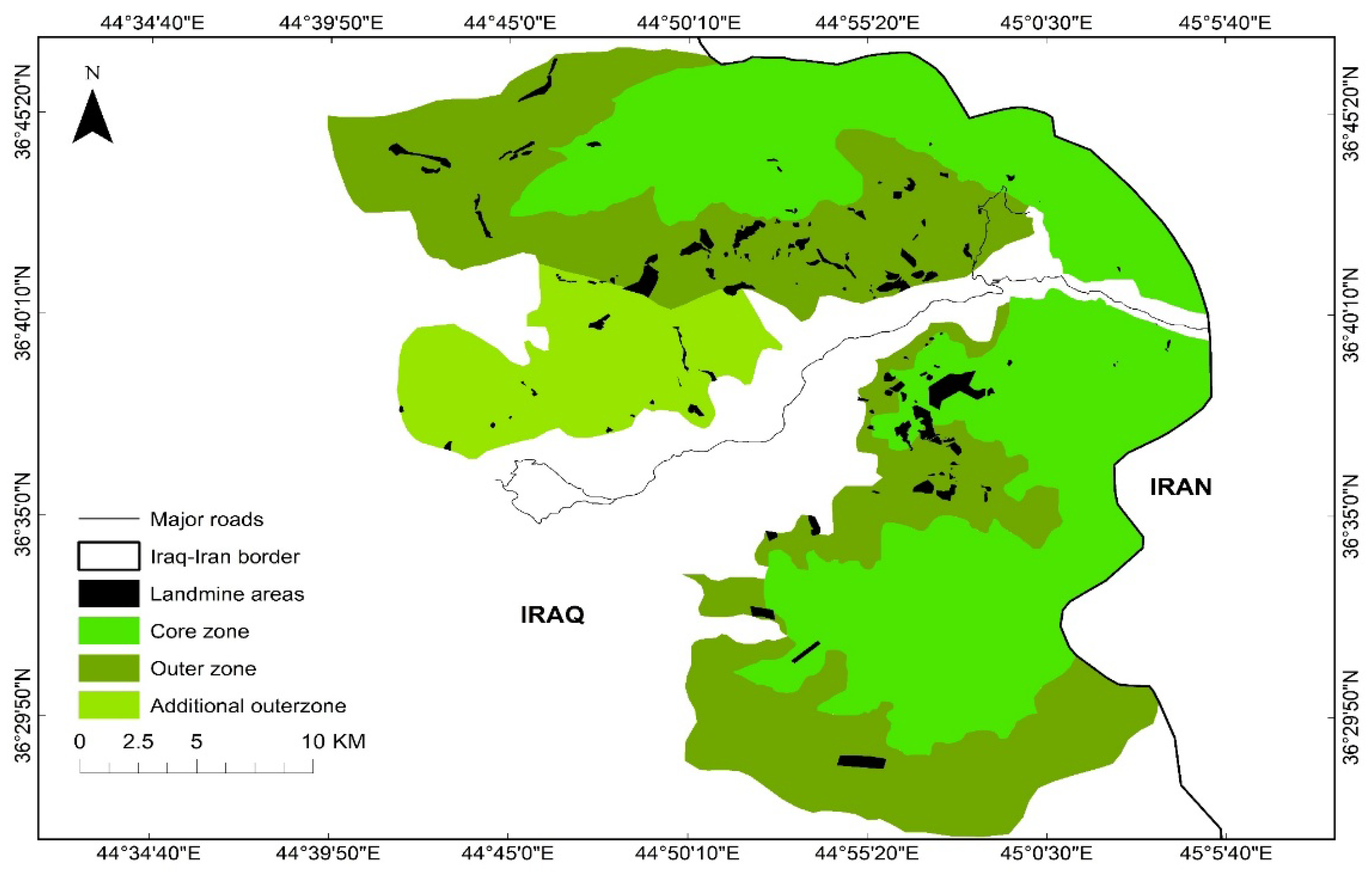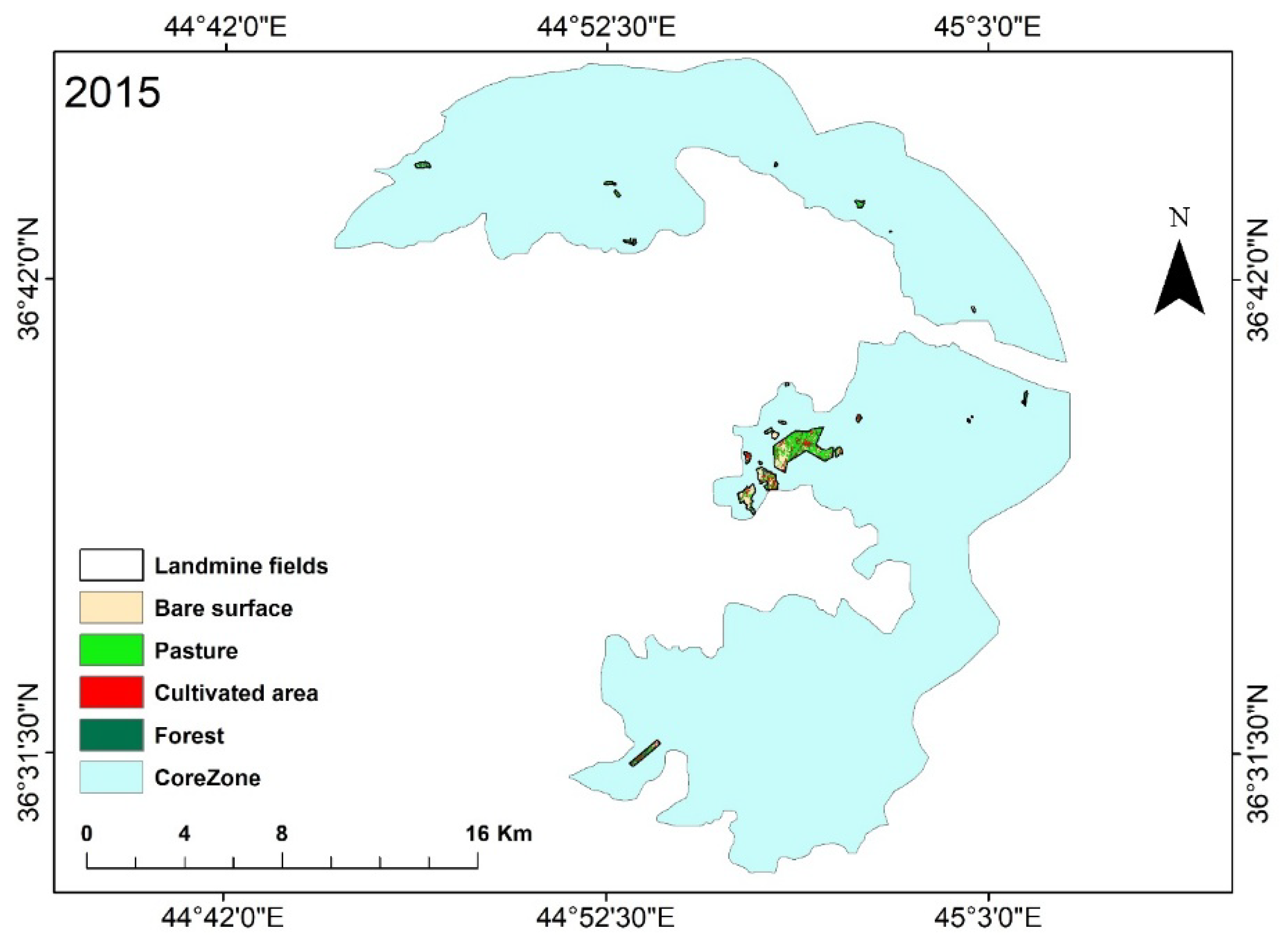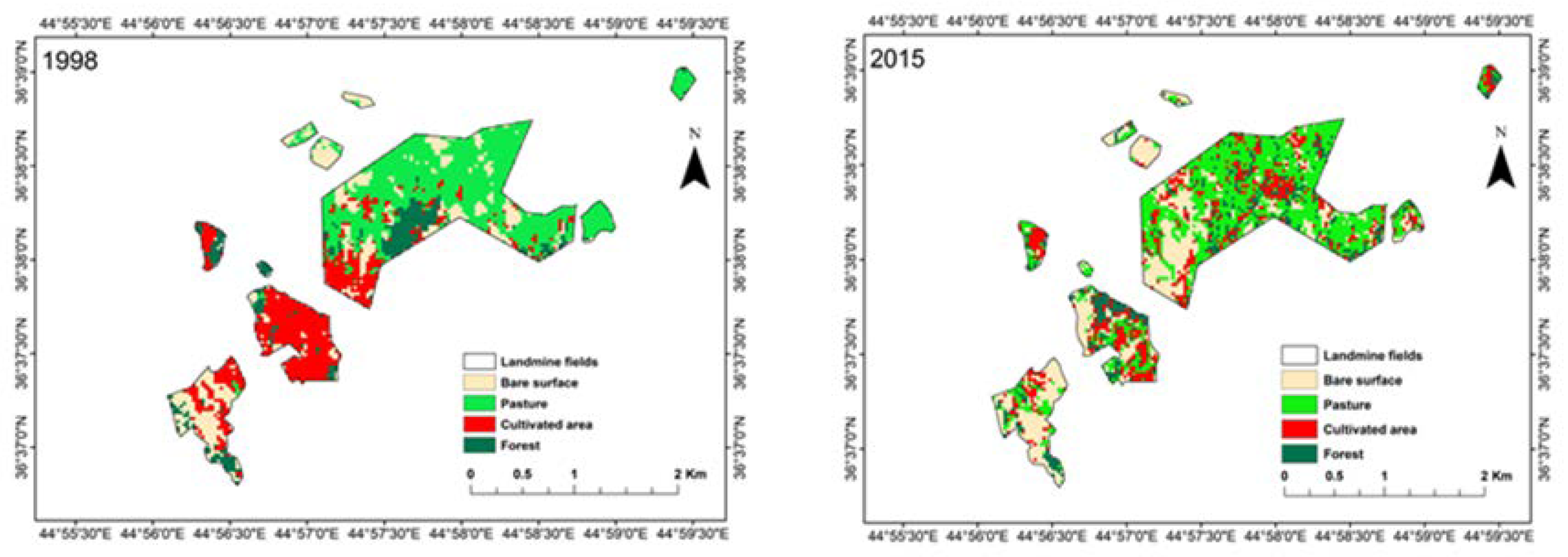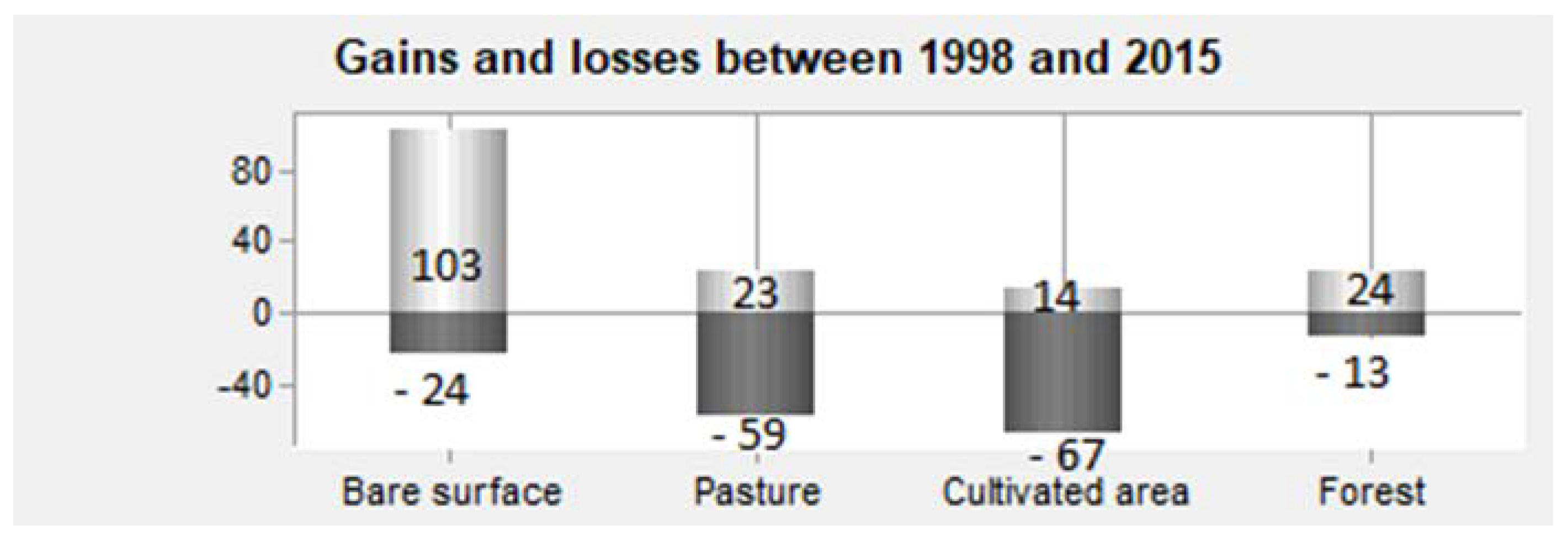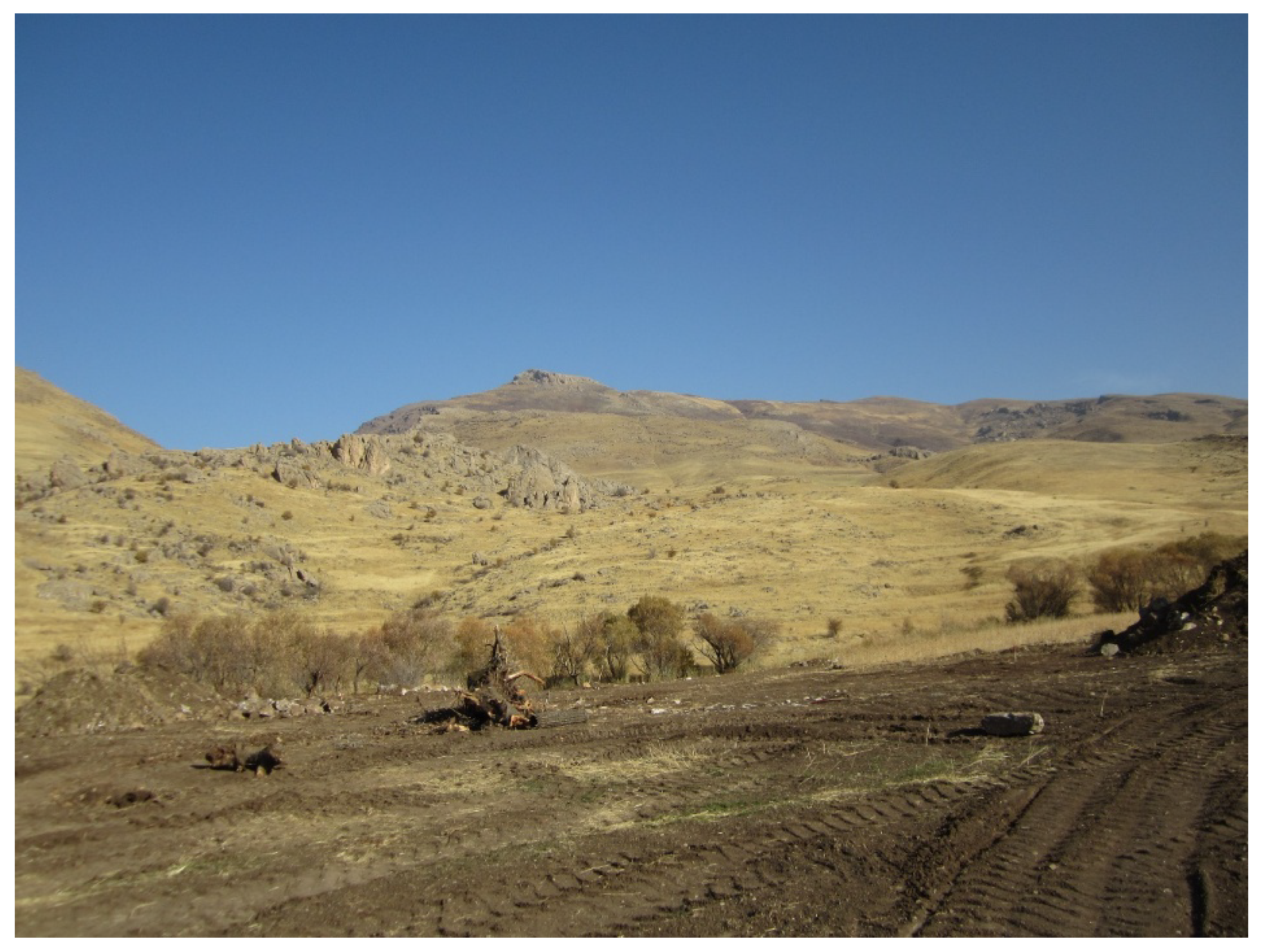4.1. Environmental Impact of Mine Action in Kurdistan
One case study has been surveyed for the whole Erbil Governorate by Shabila et al. [
6], concerning the victims of explosives remnant of war in the Erbil governorate from July 1998 to July 2007. The surveying reported that 285 victims were admitted to the Emergency Hospital in Erbil Centre with injuries that resulted in limb amputation for almost 72%, with the majority being males. Iran has also reported a high pre-hospital mortality rate in the study area on the other side of the border or previous frontline [
6]. At the worldwide level, studies had documented 5426 casualties caused by mines and explosive remnants of war in 2007, regardless of many sufferers who are still assumed to go unrecorded [
1]. However, the vast majority of landmine victims in the area of interest are civilians, and almost half of those are children. Most victims of landmines live in rural areas and small settlements and are in weak physical condition [
48]. The last survey made by IKMAA reported they have eliminated the impact of landmines in Iraqi Kurdistan. The total contamination area in Erbil, Duhok, and Sulaymaniyah governorates that was covered by mines in 2006 was around 77,600 ha, this amount of area has been reduced to less than 32,000 ha in 2016 [
11].
Certainly, the clearance of landmines in the study area will enable the civilian population to farm their lands free from fear and danger.
4.2. Landmine Clearing Process
The demining process has been conducted in the smallest patch of minefields inside the HSCZ during our visiting on 16 November 2016. A number of anti-personnel mines, unexploded ordinances, and explosive remnants of war were found, removed, and destroyed in 1366 m
2 of landmine fields. The finding mines that were placed in the digging holes and were ready to be detonated by de-miners at the site are displayed in
supplementary figures (Figure S1). The explosion took place inside the digging area in order to detonate the content of mines and other unexploded ordinances, followed by backfilling of the hole.
The act of moving soil laterally displayed in
supplementary figures (Figure S2) during mine clearance operations leads to land degradation in the area, which causes the loss of soil structure, erosion, and compaction. This area will be exposed and eroded by water and wind, which results in loss of productive soil and nutrients. This may bring problems during wet and rainy winters that may lead to increased flooding. Additionally, compacted soil induced by heavy equipment (excavator) can also be observed during clearing operations. Furthermore, human activities during mine clearance have led to degradation of land resources, which are the basis for sustainable food security and could also lead to a reduction in yields.
In our study, two categories of human induced degradation processes can be recognised: soil degradation by displacement of soil material by heavy equipment during the mine clearance operation, and soil compaction by heavy equipment. These increase the runoff during rainy seasons in the study area and reduce the pore size and change the physical soil environment. During the demining and mine clearance operations the vegetation and topsoil will be removed, which leads to damage of the natural environment and impedes the sustainability of socio-economic expansion.
Furthermore, soil productivity in the restricted landmine areas dramatically decreased as the land was contaminated during the explosions, the fertile top soil was removed, and root systems are likely to have been disrupted. Therefore, the consequences of landmine clearance processes in restricted landmine areas that cover around 420.47 ha in HSCZ could take the form of various types of land cover changes, transforming the landscape, changing soil composition, and reducing soil fertility. The total volume of de-surfaced (removed) and the amount of removed and disturbed top soil by excavator inside the restricted areas is around 0.00084 km
3 (4.20 km
2 × 0.0002 km) (
Table 7).
In other words, 840,000 m
3 of top soil has been displaced, although fertile top soil has been lost when scraped by excavator, thus soil erosion reduces its productivity primarily through the loss of plant available water capacity [
53]. Consequently, since there was no agricultural activity in the mine-suspected and cleansed areas, arable land has been substantially reduced (
Table 4).
4.3. Environmental Impact of Clearing Landmines by Heavy Equipment
Heavy equipment during mine clearance operations can create visible patterns of soil disturbance. Following the clearance operation, the cleared area can be exploited as arable land for planting crops and trees, then would be subjected to the most disturbed soil in the mosaic of soil conditions.
Figure 5 displays the impact of mine clearance on the physical and economic environment. It shows the destruction of the soil structure and vegetation as well as soil compaction as a result of operating heavy equipment that leads to reducing the infiltration rate into the soil [
43]. Thus, the clearing process will accelerate soil erosion, cause soil loss on site, and affect productivity through inducing reduction in crop yields [
54,
55]. Further, “the compaction influences the exchange of oxygen and carbon dioxide between the root zone of plants and the atmosphere” [
13].
A major environmental concern appears during the landmine clearance in the study area through the washing away by rainwater or blowing by air of the topsoil layer. However, through the heavy equipment (shovel) destroying the topsoil and through the clearance process, the following types of land degradation can occur: loss of vegetation cover, loss of soil fertility, soil structure change, and soil erosion. Moreover, land degradation is one of the main problems affecting the ecological balance of the landscape. Furthermore, soil productivity will be reduced as fertile topsoil could be lost because of the removal of the topsoil by means of scraping by heavy machineries when clearing the landmines in the Halgurd-Sakran Core Zone [
53].
The effects of heavy equipment on the physical soil properties are documented well. Many scientists have addressed the compaction of soil by heavy machinery and their impacts. For instance, Krmenec [
56] made a comparison for corn yields in compacted and non-compacted soils. The yields of corn were higher in un-trafficked soil than heavily-trafficked row soil. He also noted that the ears of corn were smaller than the ears from the non-compacted plots [
28,
56]. Soil compaction leads to changes in the amounts and balances of growth hormones in plants, especially increases in abscisic acid and ethylene, reported Kozlowski [
57]. However, DeJong-Hughes [
28] observed that the compaction in dry soil differs from wet soil, although yields under compacted wet weather would be lost as a result of increased risk of root diseases and increasing denitrification induced by decreased soil aeration. Mines can severely impede the production of food crops such as in cases where the fertile top soil is removed during the mine clearance operations of the restricted minefield land. In HSCZ the top soil in around 420.47 ha has been scraped, eventually leading to soil erosion and possible desertification, leaving an open, exposed landscape accentuated by the high drainage system of HSCZ geomorphology. This man-made damage to soil stability, though justified by the population safety constraints, would have irreversible effects, taking into consideration that this ancient soil is developed through a very slow geochemical alteration of the metamorphic-igneous and sedimentary rocks that make the bedrock of the soil. Thus, soil with less cultivated areas and plants become vulnerable, drier, and more susceptible to erosion by wind and rain. Additionally, the operations transform the landscape (
Supplementary Materials, Figures S1 and S2).
During the mine clearance operations in Halgurd-Sakran National Park (HSNP) two processes can be observed: the removal (displacement) of surface soil and soil compaction. Thus, these influence soil properties physically, chemically, and biologically. Therefore, the abovementioned studies are relevant to the current study, where these areas could be used for agricultural purposes in HSNP.
4.4. Analysis of Cultivated Area Loss and Socio-Economic Indicators
The Number of Patches (NP) decreased across all LULC classes, except pasture land. However, a decreasing NP means less fragmentation in the restricted areas. Thus, the bare surface, cultivated areas, and forest classes were less affected by fragmentation in the period from 1998 to 2015.
The overall land transformation has been observed for all classes over the last 17 years in this area. In fact, the role of existing organisations in the study area raised the awareness level, but the agricultural production activities declined sharply in areas that were covered by mines.
Furthermore, the total amount of human land use in landmine areas was relatively small in 2015 compared with 1998. The reason is that, after the major historical event in 2003, the international humanitarian organisations and non-governmental organisations (NGOs) opened the way and ran programs for development work in Iraq and the Kurdistan region. Besides, poverty in Iraq and the Kurdistan Region reduced after 2003.
Since 1991, NGOs of European countries have played an important role in rebuilding houses which were completely destroyed by the previous Iraqi regime [
10]. When rural people returned to their places after 1991’s events (the First Gulf War), they found their fertile land and farms replaced by landmine fields [
58]. Subsequently, very few people understood the importance of mine awareness education (MAE) and therefore they fell victims to such explosive devices. Increasing awareness material through sessions and workshops by organisations, especially by the Iraqi Kurdistan Mine Agency Action (IKMAA), made people more aware about the risks of landmines and other explosive ordnances. Thus, the casualties that caused by landmines have been reduced.
This awareness lead the farmers to lose their lands and jobs as they were unable to tend to their crops, as these areas were deployed with landmines and became even more undesirable. Landmines slowed down progress in HSCZ, otherwise agricultural production and productivity could have doubled.
Table 4 illustrates how the cultivated lands reduced before and after raising the awareness before and after 2003. Therefore, reducing the cultivated areas can be linked to the rising mine awareness education in order to reduce deaths and injuries from landmines and unexploded ordnance through information and education. Gebrehiwot and Kara [
3] discussed how the presence of mines in agricultural land hinders agricultural productivity. Further, a reduction in pasture land between 1998 and 2015 can be mainly attributed to the gain from bare surface. On the other hand, the trend for bare surface and forestland of the entire restricted landmine area is towards more aggregate holdings in the HSCZ. Increased forestland can be related to the socio-economic boom and stopping illegal logging for fuel wood. Islam and Sato [
59] stated that illegal logging and conversion of forest land were the ultimate causes of forest deforestation in Bangladesh.
The role of “rural–urban” and “urban–rural” migration can have linkage with this rapid change. Moreover, the re-migrants in HSCZ after 2003 learnt new skills and came back with a better economy, better life experiences, and brought back much needed human capital. For instance, the lower the level of education of the migrant, the greater importance the push factors have, argued Sridhar et al. [
41] during their primary survey of migrants in Bangalore, India.
It is worthy to mention that there was a forced migration, which was a political factor that compelled people to leave their places and migrate to another place (cities, districts, and sub-districts) during the 1980s. During their stay in the urban areas they enjoyed the same public services, performed job creation, and promoted public welfare with a better economy when they returned after the first Gulf War and particularly after the Fall of Baghdad in 2003 or after lifting the sanctions on Iraq [
47].
The degradation of ecosystems has several impacts and dimensions on rural livelihoods and management of natural resources. Researchers addressed the impact of degraded lands on sustainable natural resources. For instance, Lubowski et al. [
60] found that less intensive agricultural uses of cultivated croplands are less productive and more vulnerable to erosion than other intensified cultivated lands. This phenomenon can be observed in HSNP as land degradation and loss of biodiversity could have put the park’s ecosystems under intense pressure.
